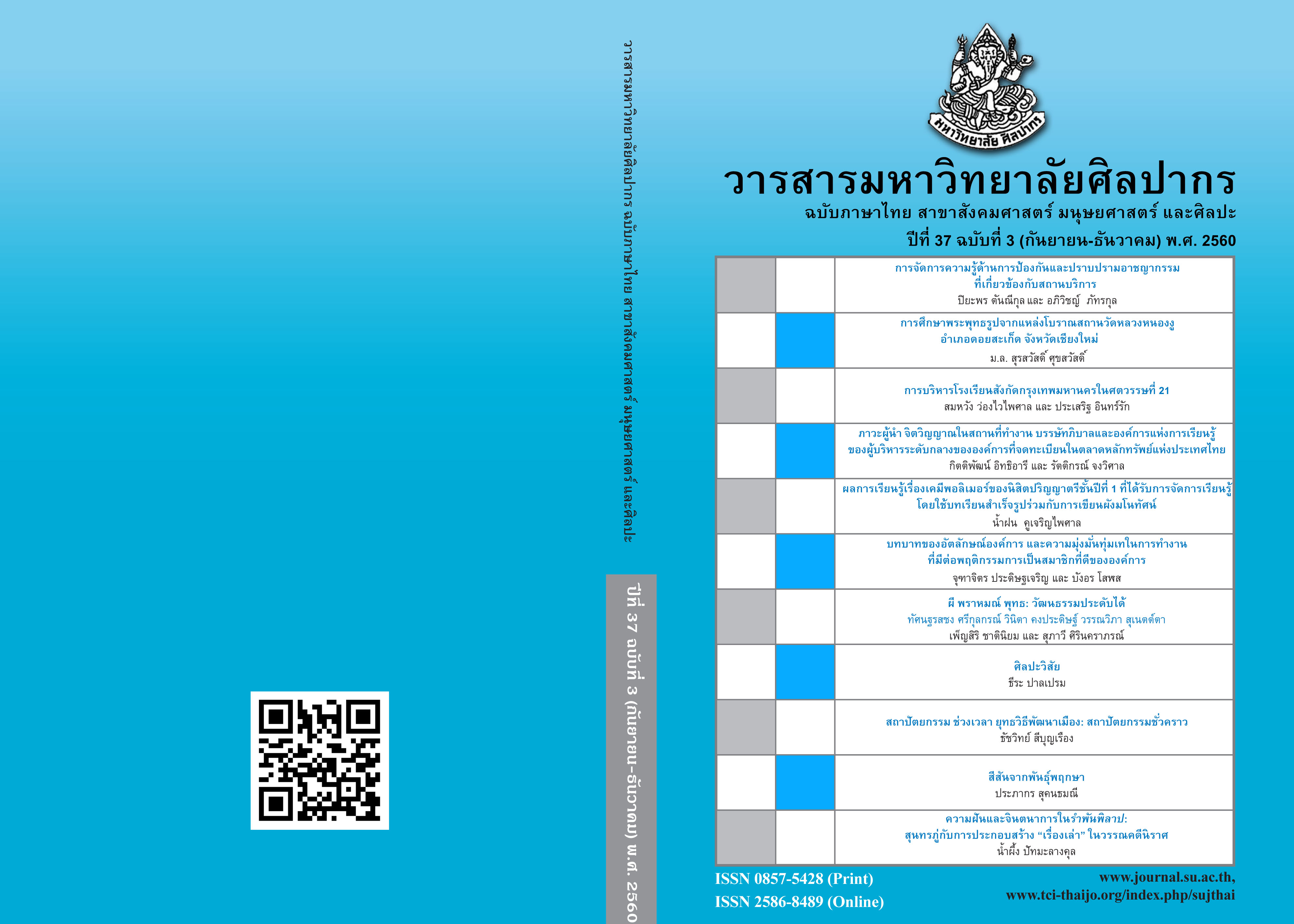การศึกษาพระพุทธรูปจากแหล่งโบราณสถานวัดหลวงหนองงู อำเภอดอยสะเก็ด จังหวัดเชียงใหม่ (Study on the Buddha Image from Wat Luang Nong-ngu Archaeological Site, Doisaket District, Chiang Mai Province)
Main Article Content
Abstract
วัดหลวงหนองงูเป็นแหล่งโบราณสถานขนาดใหญ่ในเขตอำเภอดอยสะเก็ด จังหวัดเชียงใหม่ ทางสำนักศิลปากรที่ 8 จังหวัดเชียงใหม่ได้เข้าไปขุดตรวจเบื้องต้น และได้กำหนดอายุจากหลักฐานลวดลายปูนปั้นและเศษเครื่องถ้วยที่พบว่าอยู่ในพุทธศตวรรษที่ 21 อย่างไรก็ตามในอดีตเคยมีการค้นพบพระพุทธรูปสำริดภายในบริเวณนี้หากถูกนำไปเก็บรักษาไว้ยังวัดป่าเป้า อำเภอสันกำแพง บทความเรื่องนี้จึงมุ่งจะศึกษาพระพุทธรูปจากแหล่งโบราณสถานวัดหลวงหนองงูดังกล่าว โดยการเปรียบเทียบกับพระพุทธรูปสกุลหลักของเชียงใหม่ ผลการศึกษาพบว่าพระพุทธรูปสำริดในวัดป่าเป้าซึ่งคนในพื้นที่เรียกว่าพระเจ้าแข้งคมนั้นมีลักษณะตรงกับพระละโว้หรือพระเจ้าแข้งคมในวัดศรีเกิดที่พญาติโลกราชโปรดให้สร้างขึ้นในปี พ.ศ. 2026 และพระพุทธรูปหมวดพระเจ้าเก้าตื้อที่พญาแก้วโปรดให้สร้างขึ้นระหว่างปี พ.ศ. 2047-2053 ดูเหมือนว่าพระพุทธรูปแบบพระละโว้ยังคงเป็นแรงบันดาลใจต่อเนื่องมาถึงยุคพญาแก้ว ช่างจึงนำพุทธลักษณะแบบพระละโว้ที่แพร่ขึ้นมาจากอยุธยามาผสมผสานกับพระเจ้าเก้าตื้อที่นิยมในเชียงใหม่ยุคนั้น จากลักษณะภูมิประเทศของโบราณสถานแห่งนี้อาจเทียบเคียงได้กับคติการสร้างกลุ่มศาสนสถานบนเขามีสายน้ำเล็ก ๆ ไหลผ่านที่เรียกว่าตีรถะ (Tīrtha) ทั้งยังอาจแสดงถึงความเป็นชุมชนสำคัญรายรอบเมืองหลวงเช่นเดียวกับหลักฐานที่พบแถบอำเภอสะเมิง
Wat Luang Nong-ngu is a large archaeological site at Doisaket District, Chiang Mai Province. Three years ago, the 8th Department of Fine Arts (DFA) excavated the site for a preliminary test. Based on the artifacts, northern Thai ceramic pieces, stucco motifs designed in glass flamed shape found on the site, the DFA provided the date of the site in 15th-16th century. However, it has been said that some Buddha images found on the site were taken to Wat Pa Pao, San Kamphaeng District. This article presents a comparative study between the Buddha image in Wat Pa Pao and Chiang Mai image style of art at that time. The findings are: (1) the style of art of the bronze Buddha image in Wat Pa Pao is a combination of Phra Lavo or Phra Chao Khaeng-khom in Wat Sri Kert, cast by King Tilok in 1483 C.E., with the style of Phra Chao Kao-tue image in Wat Suan Dok, cast by Phra Muang Kao in 1504-1510 C.E., (2) the style of Lavo Buddha image which spread from Ayutthaya still inspired the casting of Wat Pa Pao image in the early 16th century, and (3) the landscape and surrounding of Wat Luang Nong-ngu can be compared with Tīrtha – the concept of pilgrimage place in India. The archaeological site, however, could have been a remote community around Chiang Mai City, similar to Samoeng District.
Article Details
References
Griswold, A. B. (1957). Dated Buddha Images of Northern Siam. Artibus Asiae Supplementum XVI Publishing Co.Ltd.
Hans, P. (1976). Inscription on the Pedestal of Buddha Images in Chaing Mai City (คำจารึกที่ฐานพระพุทธรูปในนครเชียงใหม่). Bangkok:Secretariat of the Cabinet Press.
Jindasu, S. (2557). Summary of Archaeological works (excavation) on Monument No. 3, Wat Luang Nong-gnu, Tambon Mae Pong, Doisaket District, Chaing Mai Province (สรุปผลการดำเนินงานทางโบราณคดี (การขุดตรวจ) โบราณสถานหมายเลข 3 วัดหลวงหนองงู ตำบลแม่โป่ง อำเภอดอยสะเก็ด จังหวัดเชียงใหม่). Chiang Mai: 8th Office of ArchaeologySection, Chiang Mai.
Jirapat That-inchan, Deputy Mayor of the Maepong Municipality. (July 3, 2013). Interview.
Jumsai Na Ayudhya, S. (1986). Water: Origin of Thai Culture (น้ำ: บ่อเกิดวัฒนธรรมไทย). Bangkok: Thaiwattanapanit.
Kalayanamit, C.(1996). Original Thai Architecture (สถาปัตยกรรมไทยเดิม). (2nd ed.). Bangkok: Thammasat University Press.
Krairiksh, P. (2009). Thai Personality: Buddha Image Identity of Thai Buddhist Art (ลักษณะไทย: พระพุทธปฏิมาอัตลักษณ์พุทธศิลป์ ไทย). (2nd ed.). Bangkok: Amarin Printing and Publishing Co
Kramrisch, S. (2002). The Hindu Temple Vol. 1 (6th ed.). Delhi: Shri Jainendra Press.
Noonsook, P. (2003). Mandala at Khao Laung: One in Economic Basement of Tāmparalinga State (มัณฑละเชิงเขาหลวง : หนึ่งในฐานเศรษฐกิจของรัฐตามพรลิงค์). Muang Boran, 29(1), 24-27.
Phasook Indravooth, Professor of Faculty of Archaeology, Silpakorn University. (July 3, 2013). Interview.
Prachakitkorachak, P. (2516). Yonok Chronicle (พงศาวดารโยนก). (7th ed.). Bangkok: Glangwittaya Publishing.
Ratanapaññāthera. (1967). Jinakālamalīpakaranang (ชินกาลมาลีปกรณ์). Bangkok: Department of Fine Arts.
Silao Ketprom, Expert of Archive of Lan Na Inscription, Social Research Institute, Chiang Mai University. (July 3, 2013). Interview.
Sombat Thamkankang, Head of the Office of the Sumranrath Sub-districtMunicipality. (January 19, 2016). Interview.
Somthavin Thammang, Assistant Village Headman of the Huai Ang village.(July 3, 2013). Interview.
Sooksawasdi, S. (2013). Research Report: Study on Bronze Buddha Images in the Gallery of Wat Phratat Doi Suthep, Chiang Mai (รายงานการวิจัยเรื่องการศึกษาพระพุทธรูปสำริดในพระระเบียงวัดพระธาตุดอสุเทพ จังหวัดเชียงใหม่). Chiang Mai: Faculty of Fine Arts, Chiang Mai University.
Sooksawasdi, S. (2015). Lan Na Buddha Images with Tantra Buddhism, Vajrayana Sect (พระพุทธรูปล้านนากับคติพระพุทธศาสนามหายานแบบตันตระ นิกายวัชรยาน). Chiang Mai: Chiang Mai University Press.
Srisam-ang, S. (2008). Wat Benchamabopit and its National Museum: Important Buddha Images at Wat Benchamabopit Dusitwanaram (วัดเบญจมบพิตรและพิพิธภัณฑสถานแห่งชาติ วัดเบญจมบพิตร : พระพุทธรูปสำคัญ ณ วัดเบญจมบพิตรดุสิตวนาราม). Bangkok:Department of Fine Arts.
Stratton, C. (2004). Buddhist Sculpture in Northern Thailand. Chiang Mai: Silkworm Books.
Sukhata Jai-in, P. (2005). Antiquities and Arts Objects in Hariphunchai National Museum (โบราณวัตถุและศิลปวัตถุในพิพิธภัณฑสถานแห่งชาติ หริภุญไชย). Bangkok: Department of Fine Arts.
Wichienkeeo, A., & Wyatt, D. K. (2004). Chiang Mai Chronicle (ตำนานพื้นเมืองเชียงใหม่). (2nd ed.). Chiang Mai: Silkworm Books.

